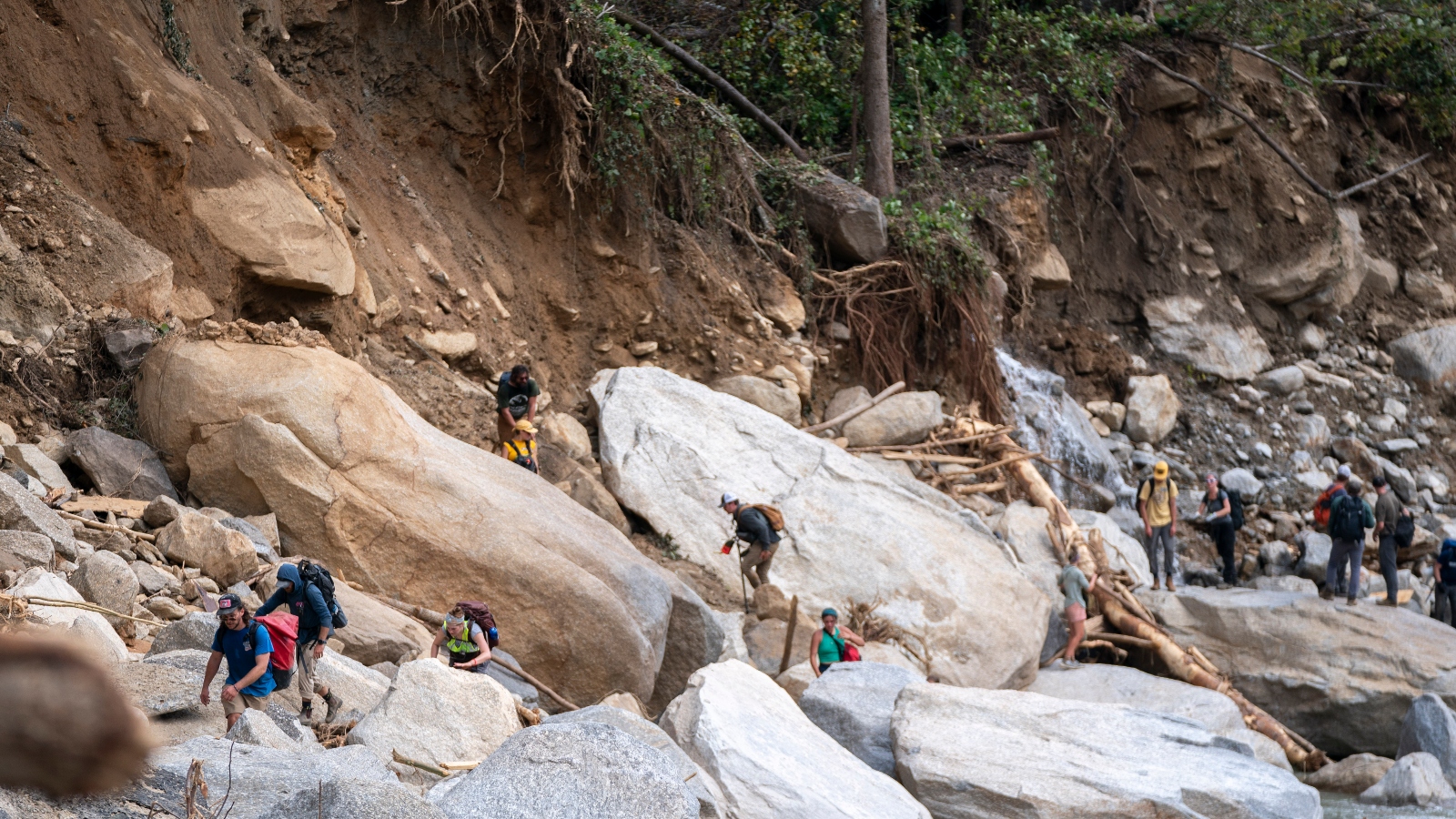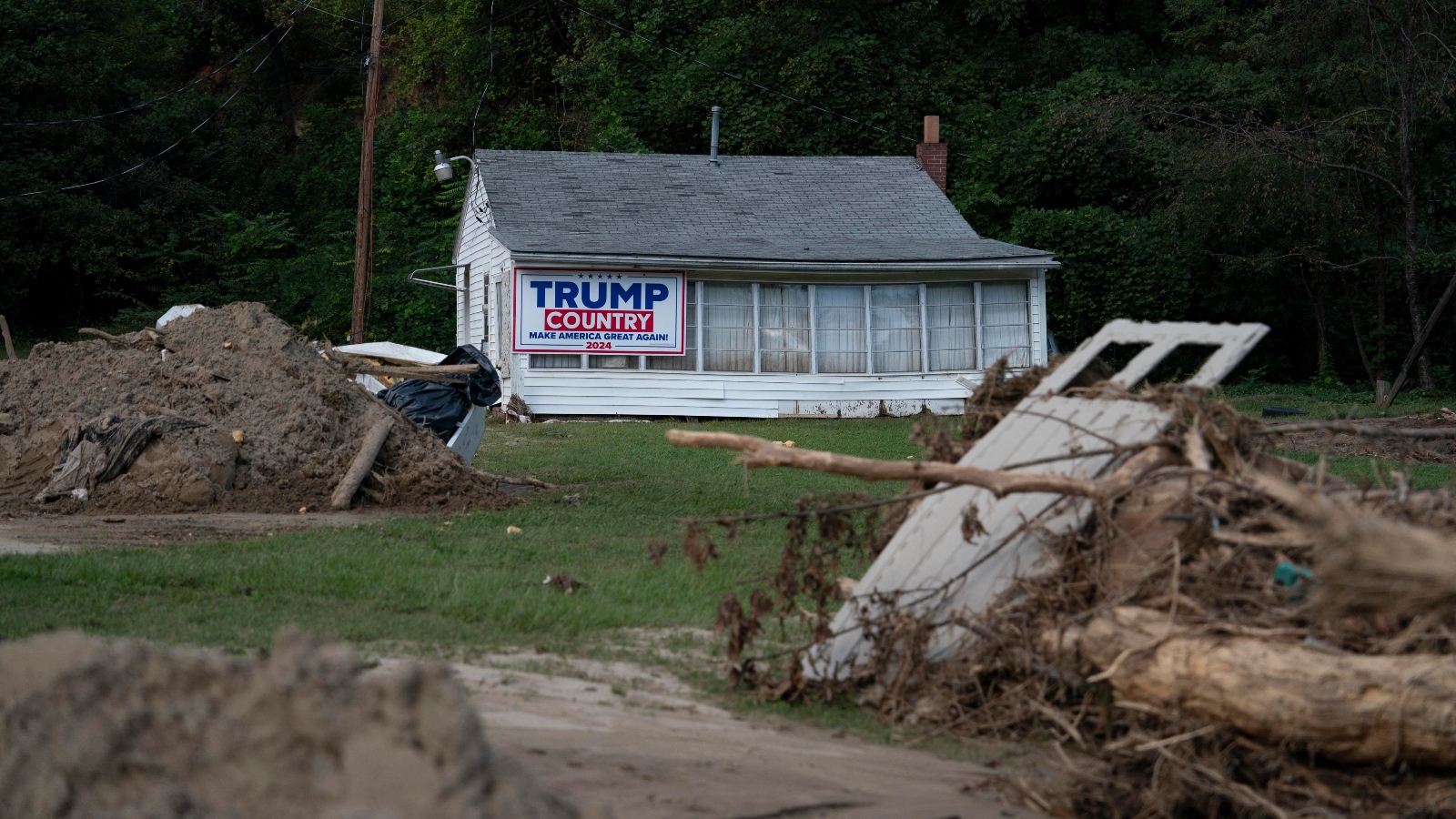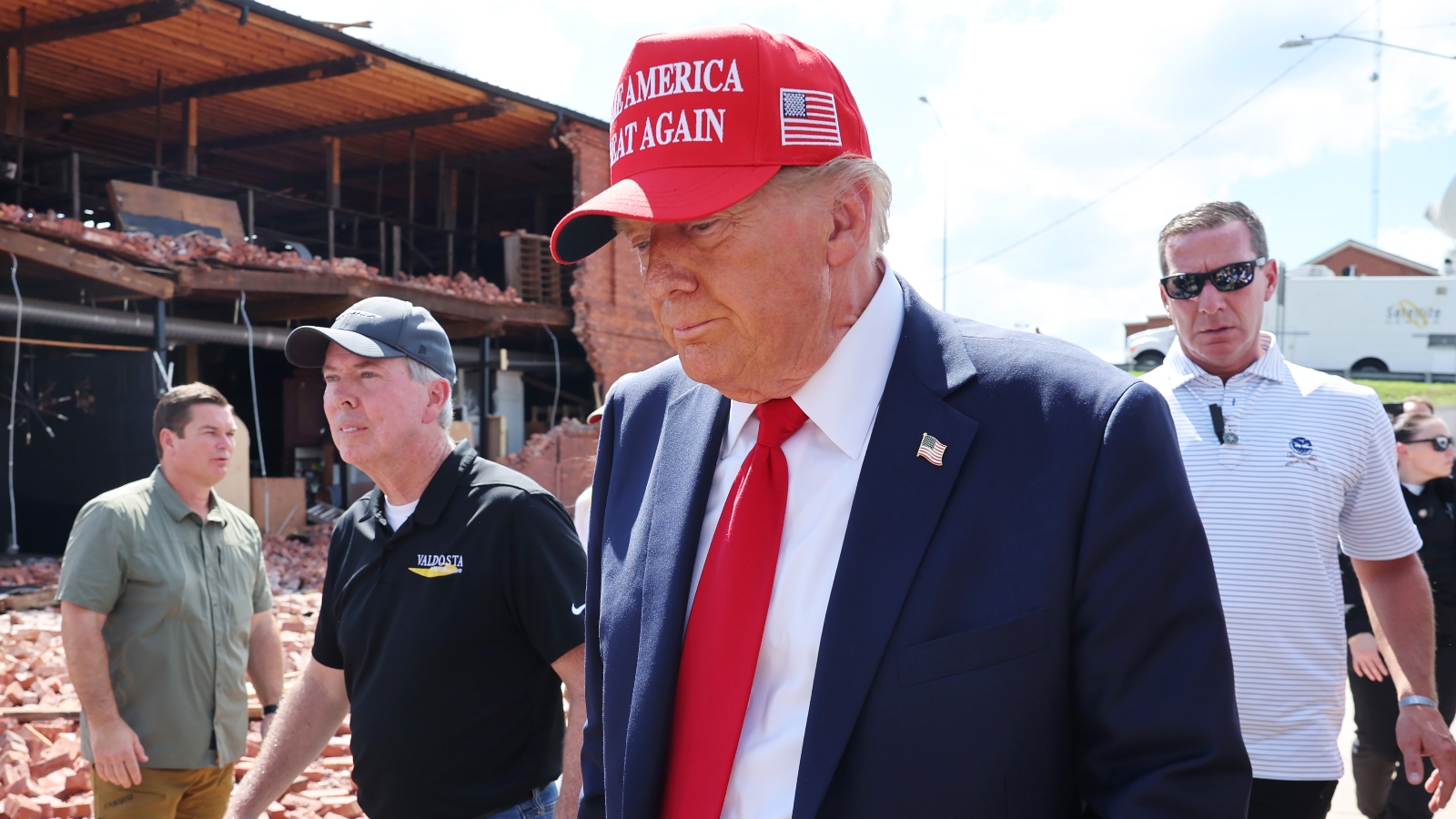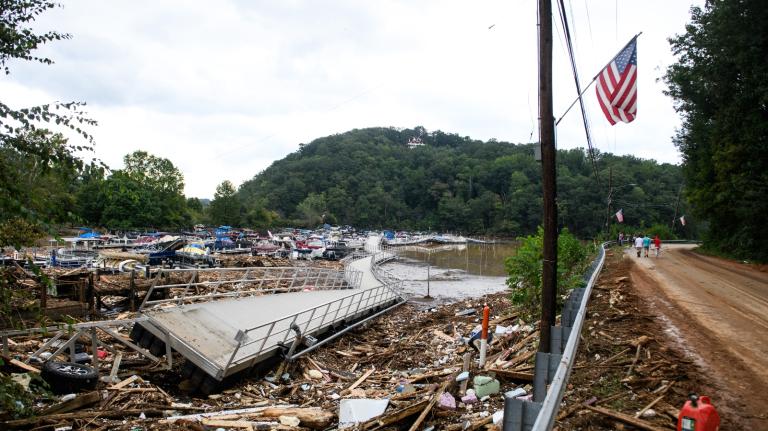This story is part of State of Emergency, a Grist series exploring how climate disasters are impacting voting and politics.
The conspiracy theories started swirling even as the floodwaters were rising: Hurricane Helene, the deadliest storm to strike the United States since Katrina in 2005, was created specifically to target Trump voters in crucial swing states. “Yes they can control the weather,” Representative Marjorie Taylor Greene, the far-right representative from Georgia, posted on X on Thursday. “It’s ridiculous for anyone to lie and say it can’t be done.”
Conspiracy theorist Alex Jones, best known for insisting the Sandy Hook school shooting was a hoax, released a video on X claiming the government aimed Helene at North Carolina. Why? To force people out of the region so it could mine the state’s large reserves of lithium, a key component in the batteries that power electric vehicles and store renewable energy. The video gleaned nearly a million views in three days.
Hundreds of keyboard conspiracists have taken to TikTok, X, Reddit, and other social media sites to say the Federal Emergency Management Administration is withholding critical supplies from stranded communities across the Southeast. “Just got down from the mountains delivering supplies,” someone with the username “RastaGuerilla” posted on X on September 30. “As crazy as it sounds FEMA is directly confiscating donated items and blocking volunteers from helping, kicking churches out of parking lots, etc.” The post received tens of thousands of likes, and similar messages from people claiming they were in the disaster zone have been racking up hundreds of thousands of views and reposts.

Sean Rayford / Getty Images
There’s no saying what percentage of these bogus claims came from people actually in the areas devastated by Helene, let alone whether humans or bots spewed them. Regardless of who or what wrote them, the conspiracies are patently untrue. FEMA is not confiscating supplies. The Biden administration is not trying to kick people off of land it wants to mine for lithium. And the federal government most certainly cannot control a hurricane. To disaster researchers, the barrage of pointed conspiracies are further proof that conspiratorial thinking is becoming something of an epidemic.
“We’ve moved into a space where conspiratorial thinking has become mainstream,” said Rachel Goldwasser, who tracks far-right activity and disinformation at the Southern Poverty Law Center. “Every tinfoil hat out there that says the government controls the weather now feels validated because Marjorie Taylor Greene said so, too.”
Disasters invariably kick up a cloud of conspiracies aimed at casting doubt on government’s legitimacy — the dark corners of society have long typecast FEMA as a sinister, all-powerful boogeyman capable of the most outlandish and fiendish deeds. During the COVID-19 pandemic, conspiracists alleged that it was seizing medical supplies from hospitals and local governments. Similar rumors about FEMA and the Red Cross confiscating donations ricocheted around the internet after the devastating wildfire in Hawaiʻi last year.
But experts told Grist that the storm’s proximity to Election Day has produced a toxic stew of conspiracies that reflect broader conversations about immigration, workplace inclusivity, and other hot-button issues that Republicans and conservative news outlets have sought to turn into cultural referendums ahead of November 5.

Allison Joyce / AFP via Getty Images
One popular theory littering online forums alleges that the government had directed money away from FEMA to fund programs for illegal immigrants. “FEMA spending over a billion dollars on illegals while they leave Americans stranded and without help is treasonous,” Tim Burchett, a Republican representative from Tennessee, said on X, without citing evidence. Another theory says the agency had prioritized diversity, equity, and inclusion, or DEI, training over disaster preparedness. Immigration, and to a lesser extent DEI, are the heart of former president Donald Trump’s reelection platform. (The former president took to Truth Social on Thursday to decry the Biden administration’s response as “the worst and most incompetently managed ‘storm,’ at the federal level,” before adding, “but their management of the border is worse!”)
“There was already a discourse around these issues and clearly there’s already people who are very concerned about them,” said Samantha Penta, a sociologist and expert on emergency management and homeland security at the University of Albany. “I’m not surprised that those concerns are being integrated into the discussion around Helene response.”
Some of the theories reflect some tiny facet of the truth. In his video, Jones cited a real government program from the 1960s called Project Stormfury as proof that the government had purposefully “seeded” the storm. The program, which explored the possibility of diminishing a hurricane’s strength by seeding it with silver iodide, ended in 1983.
Conspiracies alleging that FEMA is both absent from disaster relief efforts and confiscating supplies also contain a shred of truth based on a pervasive misconception of the role the agency plays in disaster relief. Many people believe it descends on a location with cases of water and pallets of food and armies of people with shovels and flashlights immediately after a disaster. But it is better described as a logistics coordination and check-writing organization. “You will never see someone in a FEMA jacket putting sandbags by a riverbed,” Penta said. “That is not their job.”
One of its primary roles is to coordinate relief efforts and supply distribution with local and state officials and nonprofit agencies. FEMA typically discourages people from sending supplies or going into a disaster zone, not because it wants to keep aid from the people who need it, but because all those items and untrained volunteers simply get in the way and slow down relief efforts. That’s why states often echo FEMA’s calls to stay out of harm’s way and leave recovery efforts to those who know what they’re doing.
“The state of North Carolina is advising everyone NOT to travel into the affected region,” the North Carolina Business Emergency Operations Center said in an email on Thursday. “We have live communications and power cables on roadways providing essential resources to affected communities that must not be disturbed. We also have roadways uncleared.”
The federal Department of Transportation has placed temporary flight restrictions over parts of the Southeast to prevent amateur drone operators and others from impeding rescue efforts, providing further fodder for those who insist the federal government is conspiring to prevent Good Samaritans from helping people in need. “Do not fly your drone near or around rescue and recovery efforts for Hurricane Helene,” the agency said in a post on X on Wednesday. “Interfering with emergency response operations impacts search and rescue operations on the ground.”


It is true that in the immediate aftermath of the storm, which laid waste to a wide swath of six states, many people — particularly those in remote areas or those entirely cut off by flooding — were left to fend for themselves.
Joshua Hensley, an entrepreneur who lives in Asheville, has been driving across western North Carolina delivering supplies. “Most of the government involvement we’ve seen are Ospreys and helicopters flying over trying to get stuff in and trying to evacuate people,” he told Grist on Thursday via a Starlink satellite hotspot. “But as far as on the ground, I’ve been all over the place and it is almost entirely local.”
In the days before federal aid arrived, restaurants, breweries, and other establishments in Asheville took to providing water, medical care, and other assistance to residents. “All the employees and community members have been volunteering their time and energy,” said Mae Walker, a serviceworker who lives in the city. “Much more than any visible assistance from police or other city officials outside of power restoration.”
In the days following the storm, local pilots used the airport in Asheville as a distribution center to shuttle supplies to stranded communities and conduct search and rescue operations. But as the state and federal government’s vast disaster relief apparatus groaned into motion, their efforts became more of a hindrance than a help, and airport officials asked them to stop as the state took over such operations.
The misconception that the government is not responding to a disaster, and the bogus conspiracy theories that amplify such ideas, can have dangerous implications. The Southern Policy Law Center has heard credible reports that far-right militias and white supremacist organizations are moving into the region to provide assistance — and, if past disasters are any indication, drum up sympathy for their cause.
“The more people who believe that FEMA isn’t there, or that FEMA spent all its money on DEI or whatever, the more groups like militias believe they’re needed in those areas,” Goldwasser said. “They have their own agendas and goals that they’re trying to meet that supersede the needs of the people on the ground who need help.”
It’s easy to see how, in the chaotic hours and days after a disaster, people might think the government has abandoned residents of the afflicted areas. But the conspiracy theories sprouting up online, and the politicians and pundits cultivating their spread, obfuscate the truth, which is that disaster relief work is messy and, yes, often flawed. “FEMA is an institution built and run by humans,” Penta said. “It’s going to make mistakes and things are going to go poorly and they will get criticism for that.”
Such criticism is fair, even warranted. FEMA has been chronically underfunded for decades, a situation that will only grow worse as climate-fueled disasters become more common, more devastating, and more costly. Compounding the problem is the deepening polarization of American society, and a willingness by many people to see only the worst in the government and the people who work within it. The confluence of these two trends creates the fertile ground that allows conspiracy theories to flourish — and suggests that the flood of lies will continue to rise long after the water that inundated the Southeast recedes.
This story has been updated.




